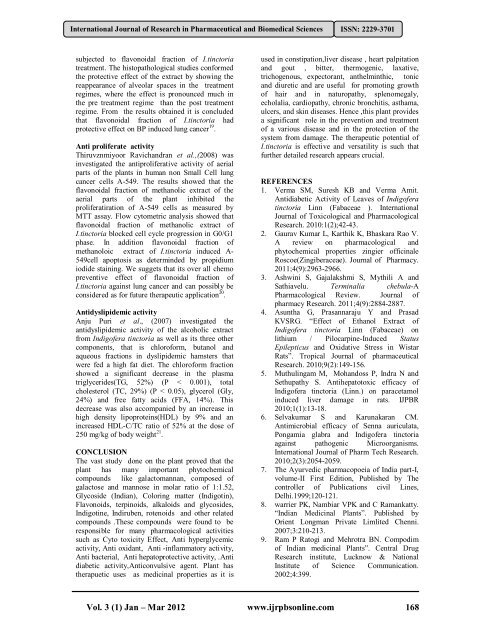Indigofera tinctoria Linn - A Phytopharmacological Review
Indigofera tinctoria Linn - A Phytopharmacological Review
Indigofera tinctoria Linn - A Phytopharmacological Review
- No tags were found...
You also want an ePaper? Increase the reach of your titles
YUMPU automatically turns print PDFs into web optimized ePapers that Google loves.
International Journal of Research in Pharmaceutical and Biomedical Sciences ISSN: 2229-3701subjected to flavonoidal fraction of I.<strong>tinctoria</strong>treatment. The histopathological studies conformedthe protective effect of the extract by showing thereappearance of alveolar spaces in the treatmentregimes, where the effect is pronounced much inthe pre treatment regime than the post treatmentregime. From the results obtained it is concludedthat flavonoidal fraction of I.<strong>tinctoria</strong> hadprotective effect on BP induced lung cancer 19 .Anti proliferate activityThiruvznmiyoor Ravichandran et al.,(2008) wasinvestigated the antiproliferative activity of aerialparts of the plants in human non Small Cell lungcancer cells A-549. The results showed that theflavonoidal fraction of methanolic extract of theaerial parts of the plant inhibited theproliferatiration of A-549 cells as measured byMTT assay. Flow cytometric analysis showed thatflavonoidal fraction of methanolic extract ofI.<strong>tinctoria</strong> blocked cell cycle progression in G0/G1phase. In addition flavonoidal fraction ofmethanoloic extract of I.<strong>tinctoria</strong> induced A-549cell apoptosis as determinded by propidiumiodide staining. We suggets that its over all chemopreventive effect of flavonoidal fraction ofI.<strong>tinctoria</strong> against lung cancer and can possibly beconsidered as for future therapeutic application 20 .Antidyslipidemic activityAnju Puri et al., (2007) investigated theantidyslipidemic activity of the alcoholic extractfrom <strong>Indigofera</strong> <strong>tinctoria</strong> as well as its three othercomponents, that is chloroform, butanol andaqueous fractions in dyslipidemic hamsters thatwere fed a high fat diet. The chloroform fractionshowed a significant decrease in the plasmatriglycerides(TG, 52%) (P < 0.001), totalcholesterol (TC, 29%) (P < 0.05), glycerol (Gly,24%) and free fatty acids (FFA, 14%). Thisdecrease was also accompanied by an increase inhigh density lipoproteins(HDL) by 9% and anincreased HDL-C/TC ratio of 52% at the dose of250 mg/kg of body weight 21 .CONCLUSIONThe vast study done on the plant proved that theplant has many important phytochemicalcompounds like galactomannan, composed ofgalactose and mannose in molar ratio of 1:1.52,Glycoside (Indian), Coloring matter (Indigotin),Flavonoids, terpinoids, alkaloids and glycosides,Indigotine, Indiruben, rotenoids and other relatedcompounds .These compounds were found to beresponsible for many pharmacological activitiessuch as Cyto toxicity Effect, Anti hyperglycemicactivity, Anti oxidant, Anti -inflammatory activity,Anti bacterial, Anti hepatoprotective activity, .Antidiabetic activity,Anticonvulsive agent. Plant hastherapuetic uses as medicinal properties as it isused in constipation,liver disease , heart palpitationand gout , bitter, thermogenic, laxative,trichogenous, expectorant, anthelminthic, tonicand diuretic and are useful for promoting growthof hair and in naturopathy, splenomegaly,echolalia, cardiopathy, chronic bronchitis, asthama,ulcers, and skin diseases. Hence ,this plant providesa significant role in the prevention and treatmentof a various disease and in the protection of thesystem from damage. The therapeutic potential ofI.<strong>tinctoria</strong> is effective and versatility is such thatfurther detailed research appears crucial.REFERENCES1. Verma SM, Suresh KB and Verma Amit.Antidiabetic Activity of Leaves of <strong>Indigofera</strong><strong>tinctoria</strong> <strong>Linn</strong> (Fabaceae ). InternationalJournal of Toxicological and PharmacologicalResearch. 2010:1(2);42-43.2. Gaurav Kumar L, Karthik K, Bhaskara Rao V.A review on pharmacological andphytochemical properties zingier officinaleRoscoe(Zingiberaceae). Journal of Pharmacy.2011;4(9):2963-2966.3. Ashwini S, Gajalakshmi S, Mythili A andSathiavelu. Terminalia chebula-APharmacological <strong>Review</strong>. Journal ofpharmacy Research. 2011;4(9):2884-2887.4. Asuntha G, Prasannaraju Y and PrasadKVSRG. “Effect of Ethanol Extract of<strong>Indigofera</strong> <strong>tinctoria</strong> <strong>Linn</strong> (Fabaceae) onlithium / Pilocarpine-Induced StatusEpilepticus and Oxidative Stress in WistarRats”. Tropical Journal of pharmaceuticalResearch. 2010;9(2):149-156.5. Muthulingam M, Mohandoss P, Indra N andSethupathy S. Antihepatotoxic efficacy of<strong>Indigofera</strong> <strong>tinctoria</strong> (<strong>Linn</strong>.) on paracetamolinduced liver damage in rats. IJPBR2010;1(1):13-18.6. Selvakumar S and Karunakaran CM.Antimicrobial efficacy of Senna auriculata,Pongamia glabra and <strong>Indigofera</strong> <strong>tinctoria</strong>against pathogenic Microorganisms.International Journal of Pharm Tech Research.2010;2(3):2054-2059.7. The Ayurvedic pharmacopoeia of India part-I,volume-II First Edition, Published by Thecontroller of Publications civil Lines,Delhi.1999;120-121.8. warrier PK, Nambiar VPK and C Ramankatty.“Indian Medicinal Plants”. Published byOrient Longman Private Limlited Chenni.2007;3:210-213.9. Ram P Ratogi and Mehrotra BN. Compodimof Indian medicinal Plants”. Central DrugResearch institute, Lucknow & NationalInstitute of Science Communication.2002;4:399.Vol. 3 (1) Jan – Mar 2012 www.ijrpbsonline.com 168

















